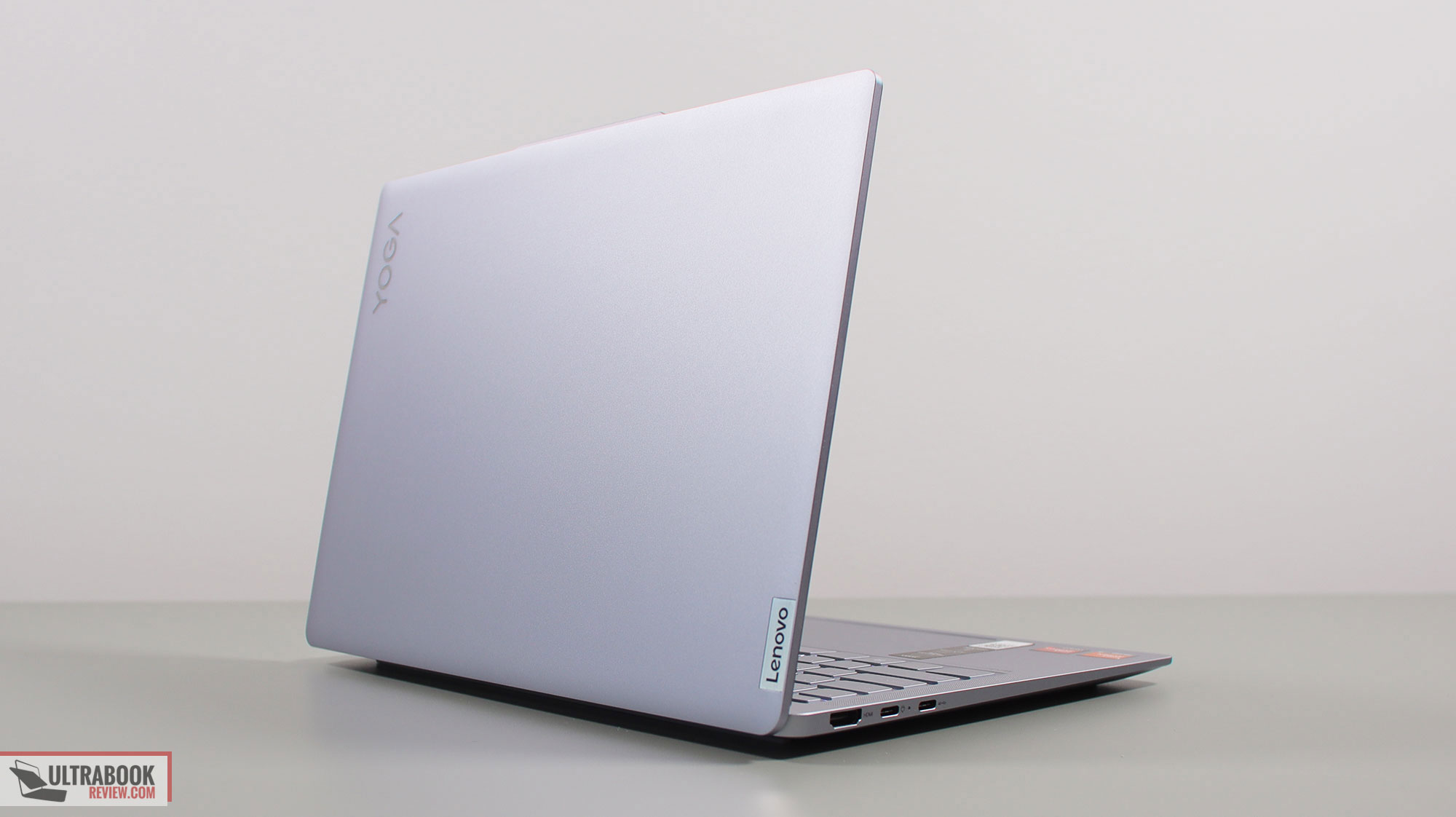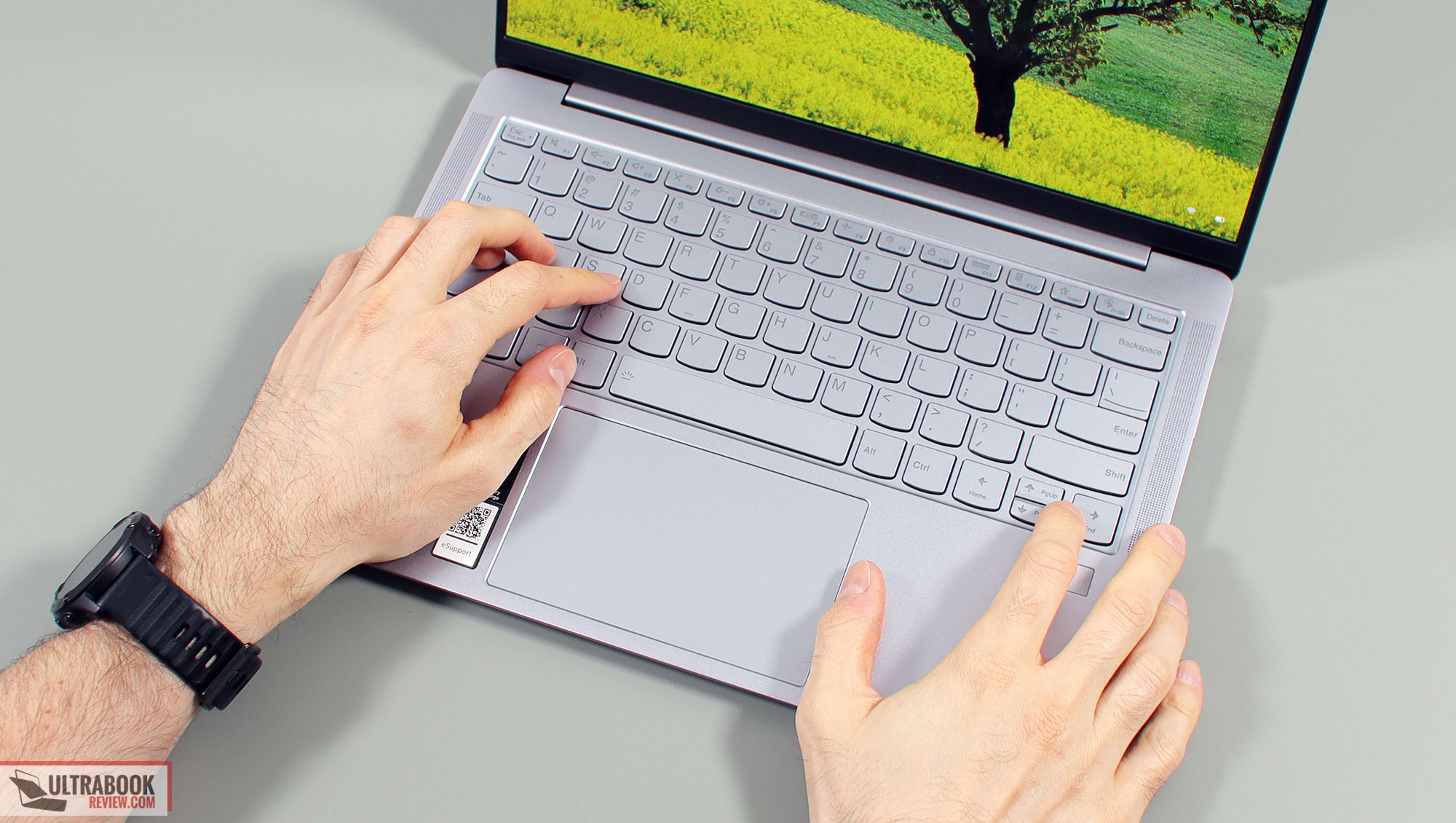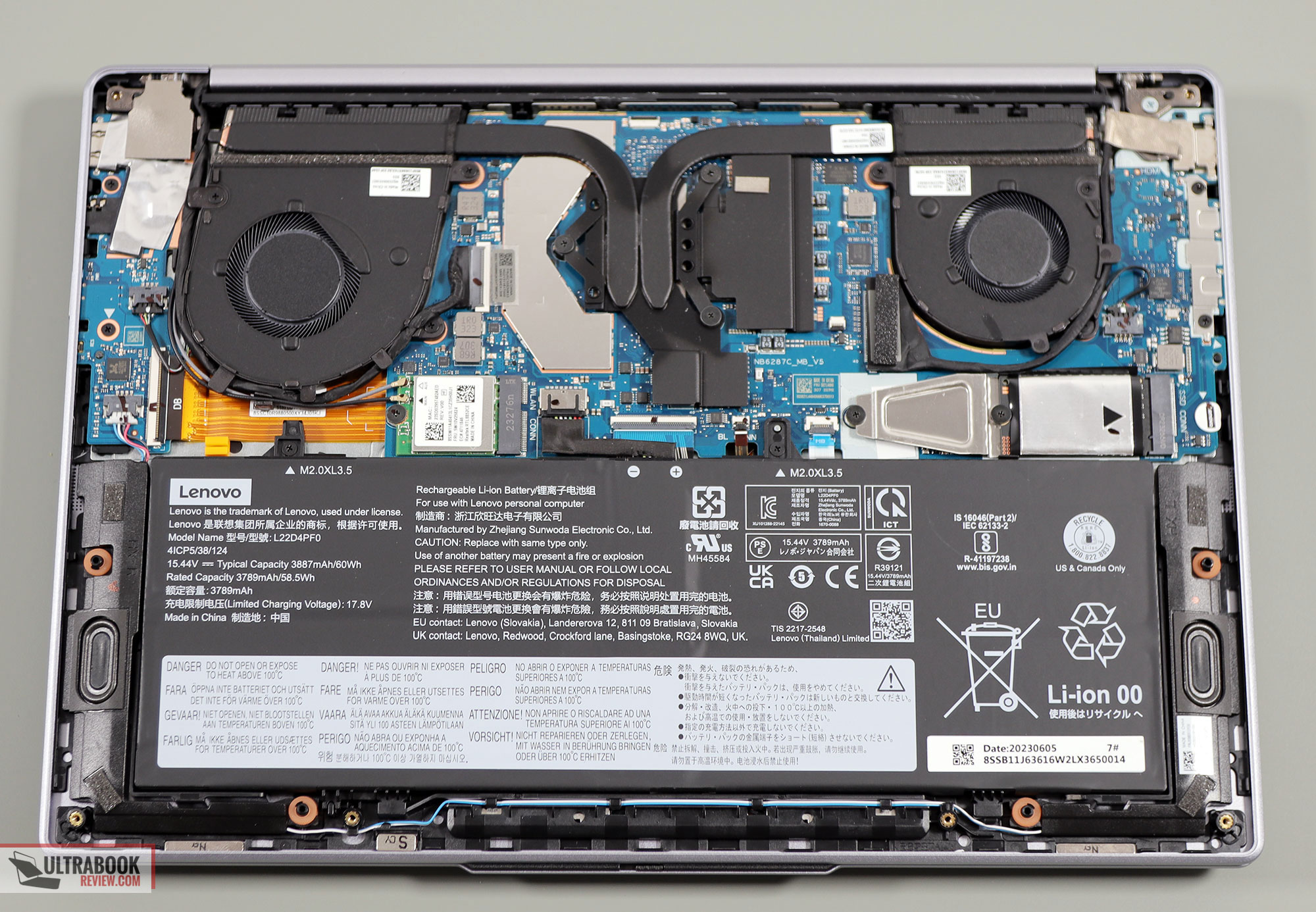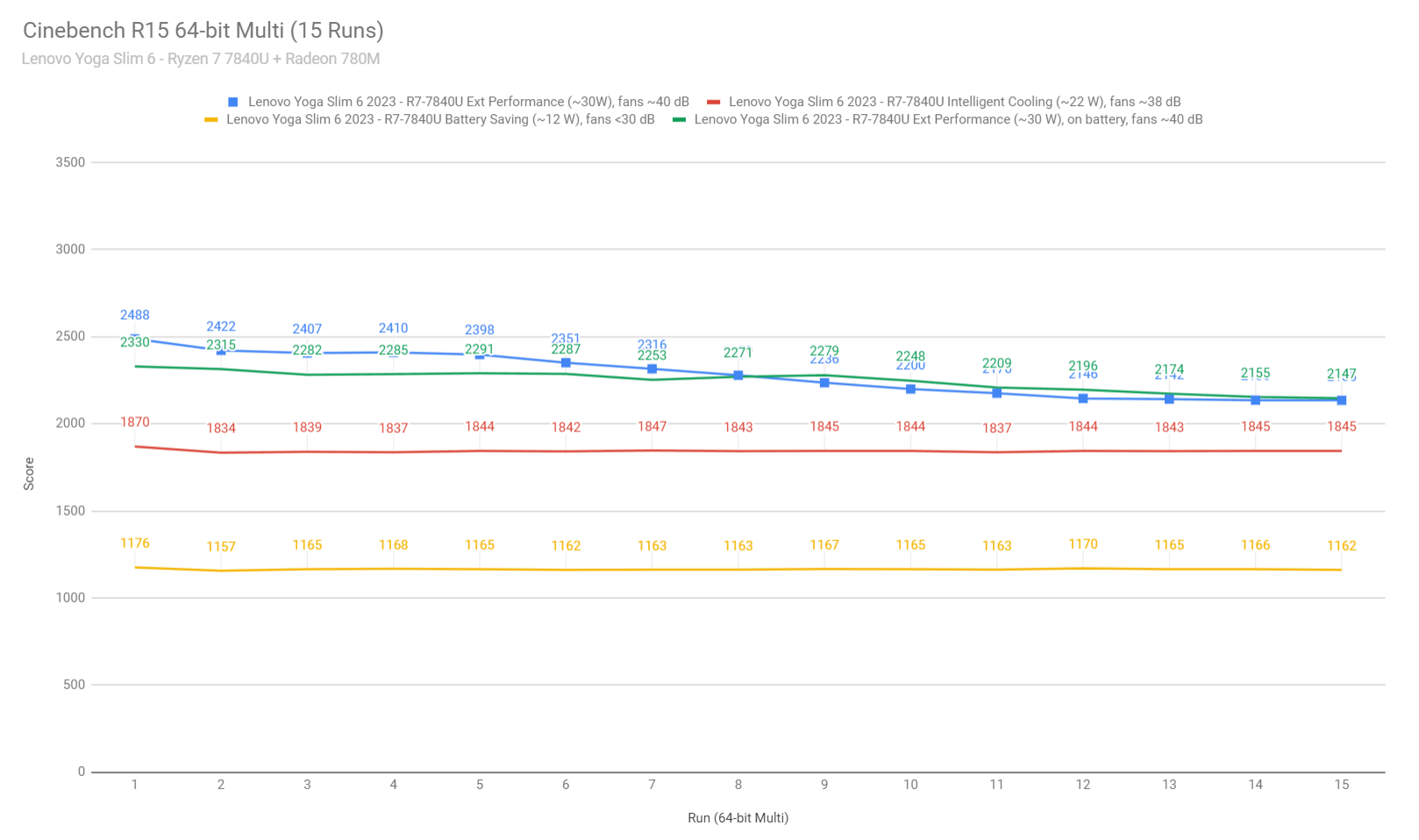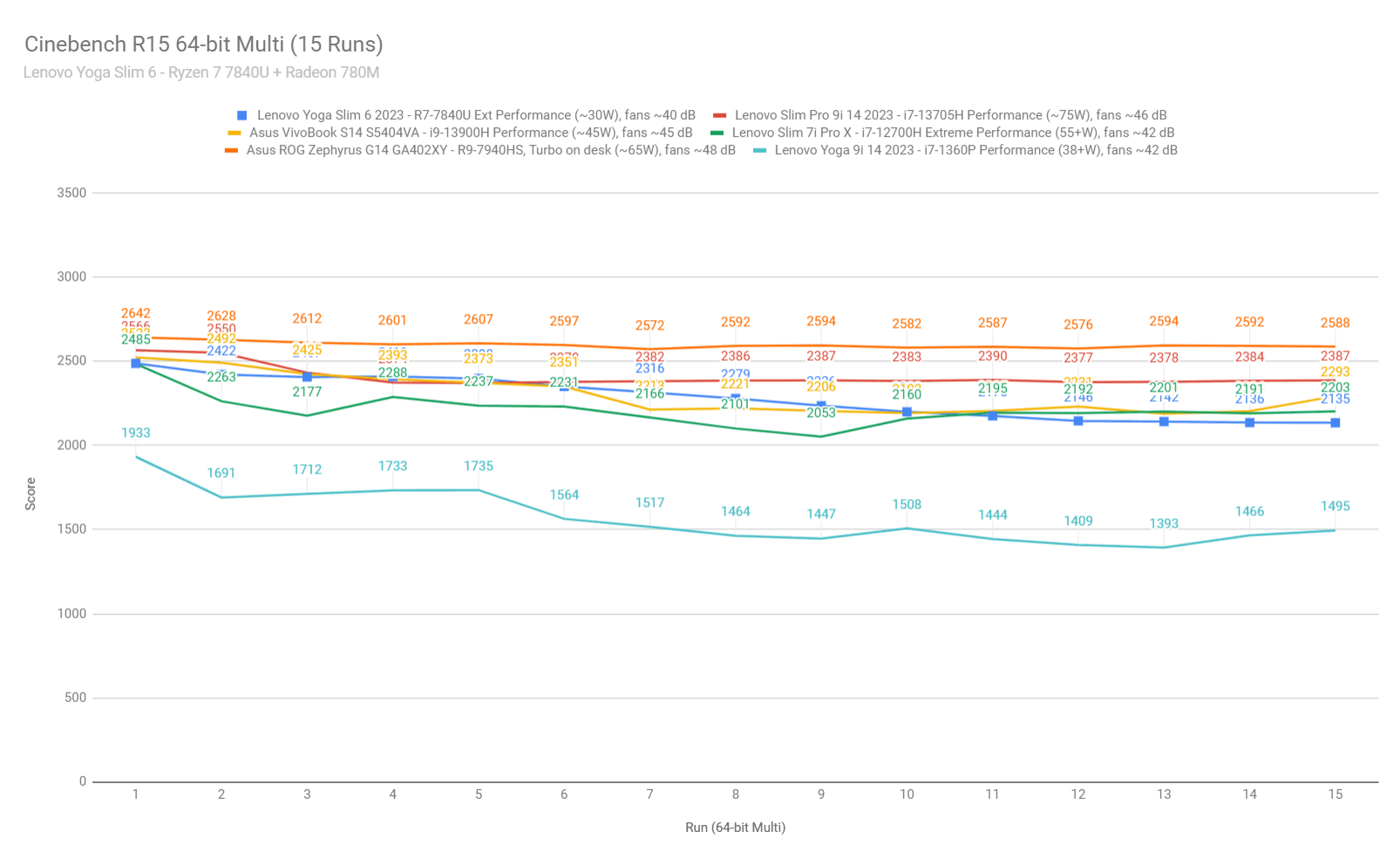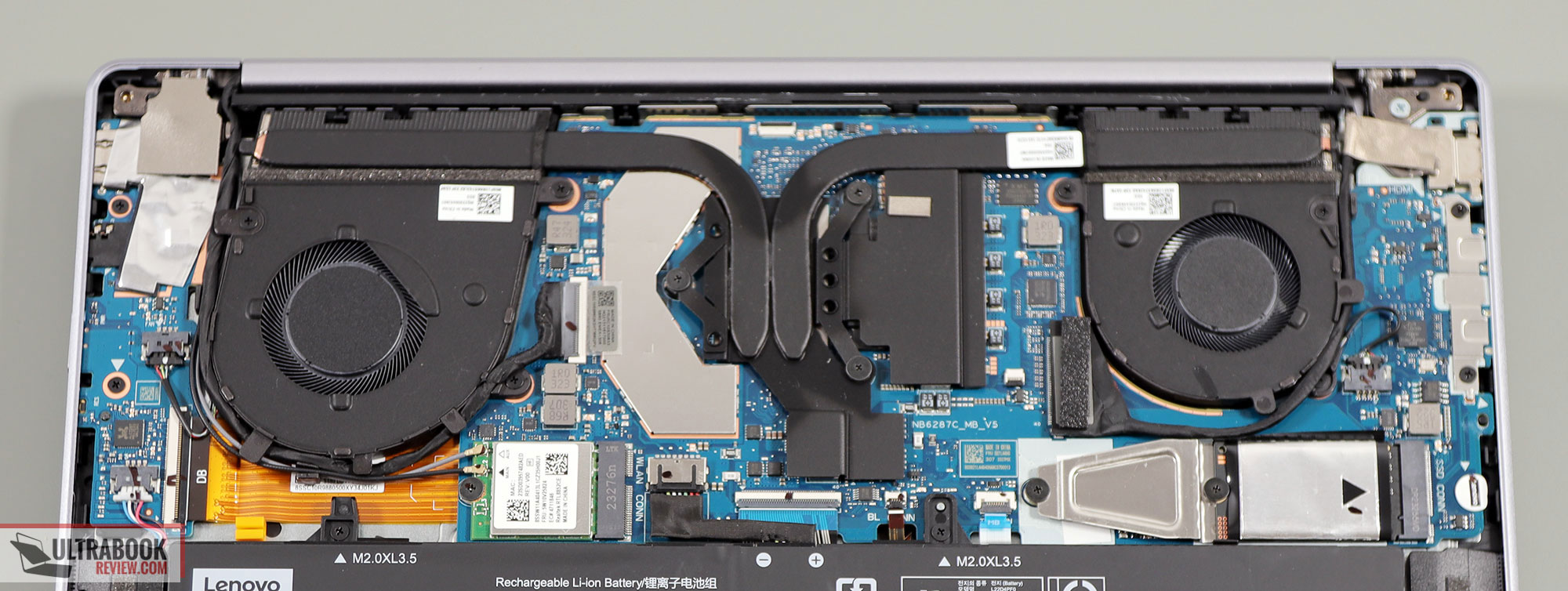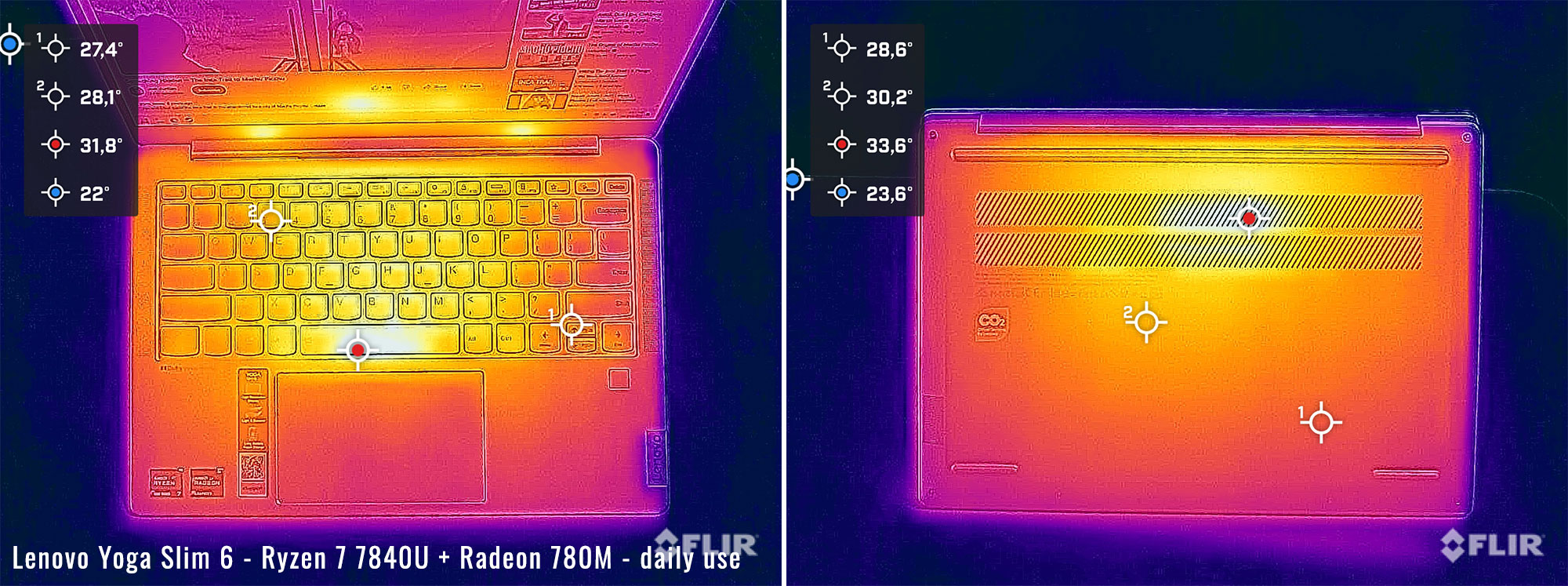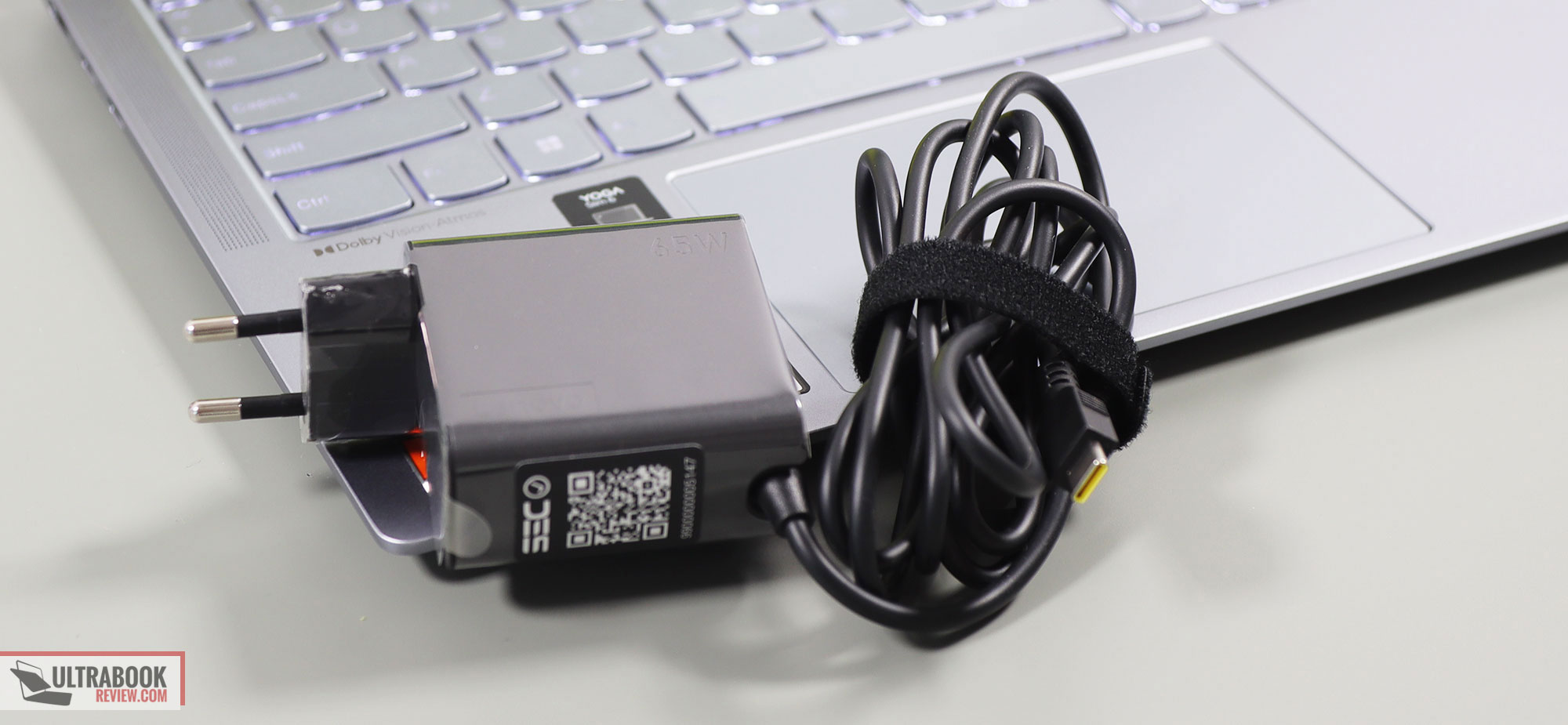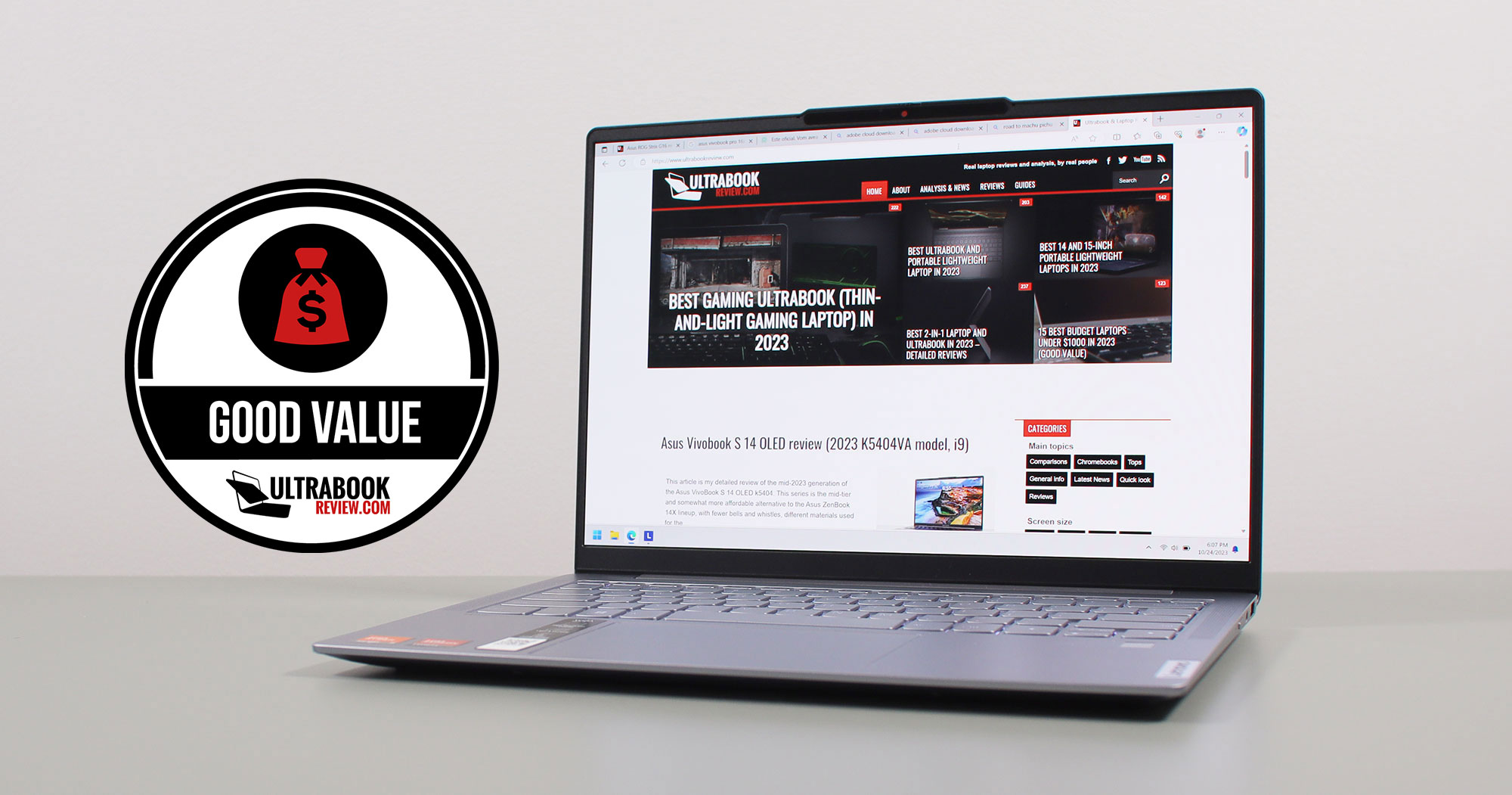This is my detailed review of the Lenovo Yoga Slim 6 series, in the AMD-based Yoga Slim 6 14APU8 variant built on 2023 AMD Ryzen Phoenix hardware.
This series is mostly available on the European market and doesn’t have a direct equivalent in the US and Canada, at least for now.
I bought this locally and paid around 800 EUR for the AMD Ryzen 7 7840U configuration with 16 GB RAM, 512 GB SSD storage, and the FHD+ OLED display. That’s an excellent configuration for the money spent, one perfectly fine for daily use and multitasking, but also capable of fair performance in workloads and gaming sessions.
Paired with the minimalist and clean design, the good inputs and the good IO, this Yoga Slim 6 series is very competitive in its class, both as a compact and portable all-purpose daily driver, but also as a potential compact work and school computer.
Down below we’ll get in-depth on all the important aspects that you should be aware of when shopping for one of these Lenovo Yoga Slim 6 units.
Specs as reviewed – Lenovo Yoga Slim 6 14APU8
| Lenovo Yoga Slim 6 14APU8 | |
| Screen | 14 inch, OLED 60Hz, glossy, non-touch, 16:10 format, FHD+ 1920 x 1200 px, 400-nits, 100% DCI-P3 color coverage |
| Processor | AMD Phoenix Ryzen 7 7840U, 8C/16T |
| Video | AMD Radeon 780M, 12CU, up to 2.7 GHz |
| Memory | 16 GB LPDDR5-6400 (soldered) – up to 16 GB |
| Storage | 512 GB gen4 SSD (Samsung PM9BA) – single M.2 2280 slot |
| Connectivity | Wireless 6 (Realtek 8852CE), Bluetooth 5.2 |
| Ports | left: 1x HDMI 2.1, 1x USB-C 3.1 gen1, 1x USB-C 4.0 (data, charging, video), right: 1x USB-A 3.2 gen1, audio jack, power button, status LEDs |
| Battery | 60 Wh, 65W charger with USB-C plug |
| Size | 312 mm or 12.28” (w) x 221 mm or 8.72” (d) x from 14.9 mm or 0.59” (h) |
| Weight | 2.97 lbs (1.35 kg) + .42 lbs (.19 kg) charger and cables, EU version |
| Extras | clamshell format with 180-degrees display, white backlit keyboard, FHD 2MPx camera with IR and shutter cover, finger-sensor, up-firing stereo 2x 2W speakers, Misty or Storm Grey color |
Design and construction
The design of this series is standard for consumer Lenovo laptops, and in line with what we’ve seen on Yoga and IdeaPad units over the last years. That means this is a simple utilitarian piece of aluminum parts, in a Misty Grey color in this variant (there’s also an option for a darker version, called Storm Grey).
The build quality is solid for the most part, with only some flex in the keyboard deck. Overall, this can compete against devices way above its price-range .
Despite being a Yoga, this laptop is a clamshell design, and not a convertible. Lenovo makes things confusing with their recent naming, so I wanted to make sure that’s clear from the get-go. The screen does go back flat to 180-degrees, though, as I’d expect on a versatile compact device.
This series is also fairly compact and lightweight for a 14-inch unit. It’s not the lightest or the smallest in the segment, but is portable enough for most use scenarios. It weighs just under 3 lbs in this reviewed configuration.
As far as ergonomics go, there’s little not to like here. Grippy rubber feet ensure good grip on the desk, the arm-rest is spacious enough, the silver materials are excellent at hiding smudges, and the hinges allows to easily picks up and adjust the screen with a single-hand. Furthermore, the status LED is on the side in the power button, and there’s no annoying light of any sort in the line of sight.
My only complaint it perhaps the somewhat sharp front-lip, which can bite into your wrists in certain conditions, and the fact that Lenovo implement a silver color-matched keyboard on this series, which we’ll discuss in a bit.
As for the IO, there’s plenty here, with an USB-A and HDMI ports, an audio jack, as well as two USB-Cs, one of them being USB 4.0.
There’s no lock and no card-reader. And the two USB-Cs are both on the left side, so you don’t have the convenience of being able to charge this on either part. But these are minor knits with this series.
Overall, this Lenovo Yoga Yoga Slim 6 is simply one of the better designs available in the sub 1000 EUR segment. It’s well built and checks most of the right boxes when it comes to ergonomics.
Keyboard and trackpad
This laptops gets a standard Yoga/IdeaPad keyboard, as well as a large clickpad, centered in the middle or the arm-rest.
The keyboard’s layout is standard for this sort of portable Lenovo laptop, with full-sized and spaced keys. The half-sized Up and Down keys are a bit weird, but everything else is right as it should be. There’s no extra column of function keys on the right side, as on other 14-inch designs, and that’s why Home/End/PgUp/PgDn are secondaries bound to the arrow keys.
The typing experience is alright. The feedback is a little mushy, and there’s a little bit of flex in the main deck. But I’d expect most to get along fine with this keyboard, even if there are better implementations out there on 14-inch ultraportables.
The keycaps are made out of plastic, and they feel a little cheap to the touch. Plus, since Lenovo went with color-matched silver keycaps on this design, their contrast is rather poor once the illumination system kicks on.
The keys are backlit, with two brightness levels to choose from, as well as an Auto-mode that only activates the lighting in dim conditions. The LEDs are bright and fairly uniform. Lenovo also throws in companion LED indicators for Caps Lock and FnLock. The illumination never times out, though, so you need to manually switch the keys off when needed, with Fn + Space.
The clickpad is spacious for a Yoga laptop and felt responsive and accurate with daily use. It’s made out of plastic, though, and feels a bit flimsy. It also rattles with firmer taps, and the physicals clicks in the corners are somewhat clunky.
As for biometrics, there are both a finger sensor on this unit, and a IR camera that works well with Windows Hello. The IR camera is an extra option though, and might not be available on all configurations.
Screen
Lenovo offers a couple of different panel options for this Yoga Slim 6 series, all being 14-inch 16:10.
Out unit is the OLED panel, with a glossy finish, and IPS matte variants are also available (either 2.2K 300-nits or 2.8K 120Hz 400-nits).
The panel on this configuration is a fair all-rounder, with FHD+ 1920 x 1200 px resolution, which is fine for a mid-tier 14-inch display, as well as the standard characteristics of OLEDs: excellent blacks and contrast, around 400-nits of max brightness, and 100% DCI-P3 color coverage. This is also a fast panel, but only 60 Hz refresh in this variant, unlike some other OLEDs that are up to 120Hz on 14-inch laptops.
Overall, this panel is awesome for daily use and content streaming, and a solid option for professional work as well. Just keep in mind that it’s glossy, so reflections can be an issue in bright environments.
At the same time, this is a non-touch OLED without a digitizer, which means it doesn’t suffer from the graininess that bother me with touch OLEDs.
Here’s what we got in our tests, with a X-Rite i1 Display Pro sensor:
- Panel HardwareID: Lenovo LEN88AC (LEN140WUXGA);
- Coverage: 100% sRGB, 95.8% AdobeRGB, 99.6% DCI P3;
- Measured gamma: 2.23;
- Max brightness in the middle of the screen: 382.37 cd/m2 on power;
- Min brightness in the middle of the screen: <5 cd/m2 on power;
- Contrast at max brightness: 1:1;
- White point: 6700 K;
- Black on max brightness: 0.0 cd/m2;
- PWM: Yes (to be discussed);
The panel came well-calibrated out of the box and proved uniform once further calibrated. And since this is OLED, you don’t have to worry about bleeding.
You do have to account for flickering, though, which can be an issue on OLEDs at lower brightness levels, when used at night for instance. As far as I can tell, this panel gets straining on the eyes and caused me headaches during the nights I’ve used the laptop, more so than other OLED laptops that I’ve tested recently. Take this with a grain of salt, though, as I don’t have the right tools to measure for flicker. But I don’t believe in coincidences, and from what I can tell, Lenovo doesn’t offer a flicker-free method of adjusting the brightness, the same way other manufacturers do on their OLED laptops. Please let me know if I’m wrong about this, get in touch in the comments section.
If flicker and glare are potential issues for you on this series, I’d recommend opting for one the IPS panels instead (if given the choice, of course). Particularly the 2.8k IPS with 120Hz refresh and matte finishing. Just keep in mind that’s only covering 100% of the sRGB gamut, so won’t look as punchy as the OLED with everyday use.
Hardware and performance
Our test model is a top-specced configuration of the Lenovo Yoga Slim 6 14APU8, with an AMD Ryzen 7 7840U processor, Radeon 780M graphics, 16 GB of LPDDR5-6000 RAM, and 512 GB of middling SSD storage.
Disclaimer: This review unit is a retail model that I bought locally with my own money. It runs on the software available as of mid October 2023 (BIOS M4CN30WW, Lenovo Vantage 3.13.72.0). This is a mature product with mature software, so little can change with future software updates.
Spec-wise, this is based on the 2023 AMD Phoenix Ryzen U hardware platform. The AMD Ryzen 7840U is the top processor in this lineup, built on Zen4 architecture with 8 Core and 16 Threads, as well as RDNA3-based Radeon 780M graphics. This portable implementation supplies the CPU with 30+W of sustained power in demanding loads.
Graphics are handled by the Radeon 780M iGPU, with 12 Compute Units and frequencies up to 2.7 GHz. The iGPU works at about 90% of its maximum potential in this portable chassis.
Our configuration also comes with 16 GB of LPDDR5-6000 memory. The RAM is soldered on the motherboard and non-upgradeable.
For storage, Lenovo opted for a mid-tier PCIe gen4 Samsung PM9B1 drive here. This is a 2242 driver, but the M.2 slot inside supports 2280 drives as well.
It is possible to open up this device to get to the internals, and it’s a fairly simple task, as the back panel is held in place by a few Torx screws, all easily accessible. Inside you’ll find the SSD slot and the WiFi module, with everything else being soldered. You’ll also notice the battery, the speakers, and the thermal module.
As far as the software goes, everything can be controlled through the Lenovo Vantage app, which offers access to the power profiles, keyboard customization options, system updates, battery settings, etc. This is one of the better system control apps in this segment.
There are three performance/thermal profiles to choose from, and you can switch between them by pressing Fn+Q:
- Battery Saving – limits the CPU at 12W sustained and keeps the fans quiet, at sub 30 dBA;
- Intelligent Cooling – limits the CPU at ~22W sustained, and ramps that fans to ~38 dBA at head-level in sustained loads;
- Extreme Performance – allows 30+W of sustained CPU power, with ~40 dBA fans at head-level in sustained loads.
I’ve kept my unit on Intelligent Cooling most of the time, and only switched to Extreme Performance for benchmarks and gaming.
The fans keep mostly idle with daily use on Intelligent Cooling, with the laptop on battery mode, and rarely kick-in with heavier multitasking. They are , however, active almost all the time if you use the laptop plugged-in, but even in this case don’t go over 30 dBA with daily multitasking.
Performance and benchmarks
On to more demanding loads, we start by testing the CPU’s performance in the Cinebench R15 loop test.
On Extreme Performance, the system runs at 50+W for a brief moment, but then the R7 7840U gradually drops towards 30W of sustained power. At 30W, the CPU keeps cool, in the mid-70s, and scores around 2100 points in Cinebench. the fans never ramp past 40 dBA, which is quiet for a top-performance profile.
The Intelligent Cooling profile cuts the fans to around 38 dBA and sets a 22W power limit on the CPU. As a result, the CPU now runs cooler at around 65 degrees Celsius. The performance takes a dip, of around 15% lower than on Extreme Performance.
Battery Saver mode aggressively limits the CPU at 12W, with quiet fans and low temperatures. But the performance in this case is about 50% of what the laptop can do on its top profile.
The laptop is an excellent performer on battery power as well, stabilizing at 30W of power on the Extreme Performance mode. This matches the plugged-in capabilities on the same profile. All these
are detailed in the following graph and logs.
To put these in perspective, here’s how this Ryzen 7 7840U implementation fares against a few other Intel/AMD platforms available in other mid-sized laptops. This is one of the better 14-inch CPU implementations available in the mid-tier segment, but you will find faster CPUs in this sort of multi-threaded load in higher-tier 14-inch devices, from all brands. Both from Intel and from AMD.
I must, however, note, that all those faster options are running as higher power than the Ryzen U on this Yoga, and they also run noisier and hotter. So when you balance all these out, the Ryzen U is an excellently balanced platform in this chassis.
We then went ahead and further verified our findings with the more taxing Cinebench R23 loop test and in Blender, confirming our above findings.
We then ran the 3DMark CPU profile test.
Finally, we ran our combined CPU+GPU stress tests on this notebook, on the Extreme Performance profile. 3DMark stress runs the same test for 20 times in a loop and looks for performance variation and degradation over time, and this unit was able to pass it with flying colors, which means the performance does not decrease with longer demanding loads, even once the heat builds up.
Next, we ran the entire suite of tests and benchmarks, on the Extreme Performance profile in Vantage, and the screen set at its default FHD+ resolution.
- 3DMark 13 –CPU profile: max – 7326, 16 – 7339, 8 – 6290, 4 – 3533, 2 – 1889, 1 – 985;
- 3DMark 13 – Fire Strike: 7368 (Graphics – 7919, Physics – 23331, Combined – 2893);
- 3DMark 13 – Night Raid: 30221 (Graphics – 36748, CPU – 15063);
- 3DMark 13 – Time Spy: 3216 (Graphics – 2883, CPU – 9352);
- Uniengine Superposition – 1080p Extreme: 1498;
- Uniengine Superposition – 1080p Medium: 4667;
- Handbrake 1.3.3 (4K to 1080p encode): 53.03 average fps;
- Handbrake 1.6.1 (4K to 1080p encode): 65.34 average fps;
- PCMark 10: 6949 (Essentials – 10420, Productivity – 9939, Digital Content Creation – 8796);
- GeekBench 5.5.0: Single-Core: 1786, Multi-core: 10962;
- GeekBench 6.0.2: Single-Core: 2325, Multi-core: 11405;
- CineBench R15 (best run): CPU 2488 cb, CPU Single Core 278 cb;
- CineBench R20 (best run): CPU 5967 cb, CPU Single Core 680 cb;
- CineBench R23: CPU 15194 cb (best run), CPU 14119 (10 min loop test), CPU Single Core 1754 CB (best run);
- x265 HD Benchmark 64-bit: 25.61 s.
And here are some workstation benchmarks, on the same Extreme Peformance profile:
- Blender 3.01 – BMW Car scene- CPU Compute: 2m 42s ;
- Blender 3.01 – Classroom scene – CPU Compute: 6m 20s;
- Blender 3.41 – BMW Car scene- CPU Compute: 2m 41s ;
- Blender 3.41 – Classroom scene – CPU Compute: 6m 24s;
- PugetBench – DaVinci Resolve: 500;
- PugetBench – Adobe After Effects: -;
- PugetBench – Adobe Photoshop: 943;
- PugetBench – Adobe Premiere: 284;
- SPECviewperf 2020 – 3DSMax: 25.52;
- SPECviewperf 2020 – Catia: 29.78;
- SPECviewperf 2020 – Creo: 51.70;
- SPECviewperf 2020 – Energy: 19.84;
- SPECviewperf 2020 – Maya: 113.68;
- SPECviewperf 2020 – Medical: 24.87;
- SPECviewperf 2020 – SNX: 120.11;
- SPECviewperf 2020 – SW: 55.36.
- V-Ray Benchmark: CPU – 10717 vsamples, GPU CUDA – 254 vpaths;
These are excellent results for a computer of this size.
On the CPU side, yes, you will get better single and multi-threaded performance with certain Intel Core H or AMD Ryzen HS implementations, but those are generally running noisier and hotter, as already mentioned earlier. Plus, those are up to 20% faster in certain loads, so not majorly more powerful.
On the GPU side, the AMD Radeon 780M chip is the fastest iGPU technology available today, especially in comparison to the Iris Xe iGPUs available on Intel devices, but also compared to the previous gen AMD Radeon 680M iGPU. We’ll have a separate article on the performance of the AMD Radeon 780M chip vs alternatives, and vs. some of the entry-level Nvidia dGPUs available today in 14-inch devices.
As far as the other profiles go on this laptop, Intelligent Cooling mode is perhaps worth a shot. The fans run at about 38 dBA on this mode, so not significantly quieter than on Extreme Performance, but the internals run cooler.
Here are some benchmark results on this mode.
- 3DMark 13 – Fire Strike: 6602 (Graphics – 7128, Physics – 19098, Combined – 2605);
- 3DMark 13 – Night Raid: 26099 (Graphics – 33018, CPU – 11932);
- 3DMark 13 – Time Spy: 2669 (Graphics – 2396, CPU – 7555);
- Uniengine Superposition – 1080p Extreme: 1387;
- CineBench R15 (best run): CPU 2288 cb, CPU Single Core 279 cb;
- CineBench R20 (best run): CPU 5609 cb, CPU Single Core 678 cb;
- x265 HD Benchmark 64-bit: 39.86 s.
- Blender 3.01 – BMW scene – CPU Compute: 4m 11s;
- Blender 3.01 – Classroom scene – CPU Compute: 9m 30s;
- SPECviewperf 2020 – 3DSMax: 24.66;
- SPECviewperf 2020 – Catia: 28.11;
- SPECviewperf 2020 – Maya: 110.40;
The CPU performance takes a significant dip in longer sustained loads, but the iGPU runs at about 90% of its capabilities on Extreme.
There’s also Battery Saver mode, but that greatly limits the allocated CPU power, and is not something I’d consider for any sort of demanding load. So I haven’t ran any test on this profile.
Gaming performance
This Lenovo Yoga Slim 6 is not a gaming laptop, but since it bundles the most capable iGPU tech currently available, I do expect many of you to game on it at least occasionally. So we’re going to take a deeper dive into its gaming abilities in this section.
For our tests, I’ve set the screen at FHD+ and the graphics settings to low.
| Low settings | Lenovo Yoga Slim 6 2023 – R7-7840U, Rad 780M, 30W, FHD+ 1200p |
Vivobook S 14 2023 – i9-13900H, Iris Xe, 45W, FHD+ 1200p |
ZenBook S 13 2023 – i7-1355U, Iris Xe, 20W, FHD+ 1200p |
ZenBook S 13 2022 – R7-6800U, Rad 680M, 15W, FHD+ 1200p |
ZenBook 14 2022 – i7-1260P, Iris Xe, 30W, FHD 1200p |
| Bioshock Infinite (DX 11, Low Preset) |
140 fps (79 fps – 1% low) | 96 fps (62 fps – 1% low) | 80 fps (52 fps – 1% low) | 102 fps (63 fps – 1% low) | 70 fps (48 fps – 1% low) |
| Doom: Eternal (Vulkan, Medium Preset) |
74 fps (52 fps – 1% low) | 38 fps (30 fps – 1% low) | 29 fps (23 fps – 1% low) | 45 fps (34 fps – 1% low) | 29 fps (15 fps – 1% low) |
| Far Cry 5 (DX11, Low Preset) |
48 fps (36 fps – 1% low) | 32 fps (24 fps – 1% low) | 29 fps (22 fps – 1% low) | 45 fps (34 fps – 1% low) | 31 fps (22 fps – 1% low) |
| Far Cry 6 (DX11, Low Preset) |
39 fps (29 fps – 1% low) | – | – | – | – |
| Dota 2 (DX 11, Best Looking Preset) |
72 fps (41 fps – 1% low) | 77 fps (51 fps – 1% low) | 62 fps (32 fps – 1% low) | 74 fps (46 fps – 1% low) | 76 fps (52 fps – 1% low) |
| Shadow of Tomb Raider (DX12, Lowest Preset, no AA) |
59 fps (34 fps – 1% low) | 41 fps (25 fps – 1% low) | 26 fps (198 fps – 1% low) | 47 fps (35 fps – 1% low) | 36 fps (23 fps – 1% low) |
| The Witcher 3: Wild Hunt (DX 11/12, Low Preset, Hairworks Off) |
*41 fps (24 fps – 1% low) | *38 fps (27 fps – 1% low) | *29 fps (21 fps – 1% low) | 41 fps (26 fps – 1% low) | 38 fps (20 fps – 1% low) |
- Doom, Dota 2, Witcher 3 – recorded with MSI Afterburner in game mode;
- Bioshock, Tomb Raider games – recorded with the included Benchmark utilities;
- *Witcher 3 results for the 2023 models are different than on previous devices, due to the changes brought to the game by the 2023 DX12 updates and patches.
We got 30-40+ fps on all the tested title, and older games might even allow for medium/high settings. But this is nonetheless an iGPU platform, so don’t expect wonders.
With that out of the way, let’s go through some CPU/GPU logs.
First of, the Extreme Performance profile allows the GPU to run at 30W sustained power between the tested titles. This allows the GPU to run at about 2.4 GHz on average, which is about 85-90% of its 2.7 GHz ideal frequency. That means the Performance could be aroudn 10% higher in an implementation that would allow for higher sustained power, around 40W or so. But 90% is still good enough, especially when considering the noise and temperatures.
The fans ramp up to 40 dBA, and the CPU package runs at mid-60s Celsius, both with the laptop flat on the desk, and with it bumped up on a stand to improve airflow into the fans. These are excellent temperatures and noise levels for this class.
You could also consider running loads on the Intelligent Cooling mode. But this caps the CPU power to 22W, which limits both the CPU and GPU frequencies. The internals run a few degrees cooler and the fans a little quieter in this mode, but overall the loss in framerates is not worth it here.
However, this laptop performs very well when unplugged, averaging 30W of sustained GPU power in Witcher 3. This means this platform and implementation offers similar performance with the laptop plugged in or on battery use, which very few other devices offer today. Just don’t expect this to run for more than 1 to 1.5 hours of gameplay at full-load.
Noise, Heat, Connectivity, speakers, and others
Lenovo went with a fairly advanced thermal module here. This implements two mid-capacity fans, with two radiators and two independent heatpipes that feed into each radiator ensemble. This is a rather odd design, but it works.
Sure, this is a lesser cooling module than what Lenovo offer on their Slim Pro 7 and Pro X models, which also translates in the lower sustained CPU power on Extreme Performance. But don’t forget this Yoga Slim 6 series is a lower-tier lineup, so some sacrifices are understandable. And it’s not like this thermal module is not well matched for this laptop, though.
As far as the noise goes, the fans spin at up to 40 dB at head-level on the Extreme Performance and up to 38 dB on Intelligent Cooling, based on load.
On the other hand, with daily use, this Yoga runs mostly Silent on battery use, and quietly when plugged in. I haven’t noticed any coil whine or electronic noises on this unit, but that’s no guarantee you won’t experience any on your unit.
As far as external temperatures go, there’s nothing out of ordinary here. The middle of the chassis heats-up with sustained loads on the Extreme Performance profile, but even so temperatures barely go over 40 degrees Celsius in the warmest spots, and the WASD and arrows regions keep at sub 35 C. And even if the exhausts are placed under the screen, the panel doesn’t go over 35 degrees Celsius, which is perfectly fine and won’t cause any issues.
*Daily Use – streaming Netflix in EDGE for 30 minutes, Intelligent Cooling Mode, fans at 0-30 dB
*Gaming – playing Witcher 3 for 30 minutes, Extreme Performance Mode, fans at 40 dB
For connectivity, there’s latest gen WiFi 6E and Bluetooth 5.1 with a Mediatek module on this unit. It performed well with our setup and the signal and performance remained strong at 30 feet, with obstacles in between.
Audio is handled by a set of stereo speakers that mostly fire through the grills placed on the underbelly, but some of the sound is also directed through the grills at the left and right sides of the keyboard. They’re averagely loud, at around 75 dBA, and not much in quality, but generally fine for daily use.
As for the camera, there’s a 2MPx FHD shooter placed at at the top of the screen, with a wider angle, a physical shutter cover, and IR functionality. This camera is alright for occasional calls, especially in a well-lit environment. Microphones are also placed at the top of the screen, and they’re OK for calls as well.
Battery life
There’s a 60 Wh battery inside this Yoga Slim 6 series, mid-sized for the class.
Here’s what we got on this unit, with the screen set at around 120-nits (60% brightness).
- 8 W (~7-8 h of use) – text editing in Google Drive, Best Battery Mode, screen at 60%, Wi-Fi ON;
- 8 W (~7-8 h of use) – 1080p fullscreen video on Youtube in Edge, Best Battery Mode, screen at 60%, Wi-Fi ON;
- 7.5 W (~8 h of use) – Netflix fullscreen in Edge, Best Battery Mode, screen at 60%, Wi-Fi ON;
- 12 W (~5 h of use) – browsing in Edge, Intelligent Cooling Mode, screen at 60%, Wi-Fi ON;
- 45 W (~1.25 h of use) – gaming – Witcher 3, Extreme Performance Mode, screen at 60%, Wi-Fi ON.
Not bad.
The laptop ships with a 65W charger that plugs in via USB-C, which is uncommon for the mid-tier segment, where most units still ships with barrel-plug chargers. It’s a single-piece design with a compact brick and long and thick cables. A full charge takes about 2 hours, with quick charging at the beginning.
Price and availability- Lenovo Yoga Slim 6
The Lenovo Yoga Slim 6 series is available in stores at the time of this post, but as mentioned earlier, it only sells on Europe, and not on the US/Canadian markets. That’s a pity.
I paid around 800 EUR for this Ryzen 7 + 16 GB RAM + 512 TB SSD + the OLED display configuration here in Romania, which was a great deal. From what I’m seeing, the various configurations go for between 800-1100 EUR/GBP in countries such as Germany, Franke or the UK.
And most of the available configurations bundle the IPS display options, instead of the OLED here.
Follow this link for updated prices and configurations in your region.
Final thoughts- Lenovo Yoga Slim 6 14PAU8 review
This Lenovo Yoga Slim 6 is one of the best-value mid-range laptops available today.
It’s built well and looks good, offers good inputs and IO and a beautiful display, and bundles competent hardware that can handle daily chores and occasional work/gaming loads well. All for way under 1000 EUR. My only concern is with the OLED panel on this variant; if possible, I’d rather get one of the IPS options.
As far as the competition in this space goes, options such as the Acer Swift OLED, the Asus ZenBook 14 and ZenBook 14X, or the Lenovo Yoga Pro 7 should be on your list, as some other competitive 14-inch thin and lightweight laptops. But most of those are more expensive and perhaps not as better balanced as this Yoga.
This wraps-up my time with the Lenovo Yoga Slim 6. My unit is going back because of the strain caused by the OLED, but I can still answer your questions down below, and I’m also looking for your thoughts and feedback on this series.

